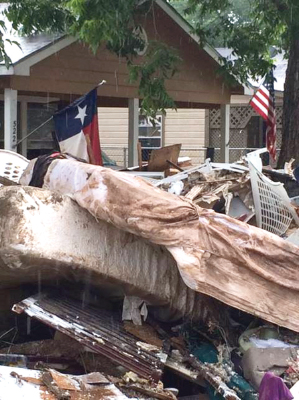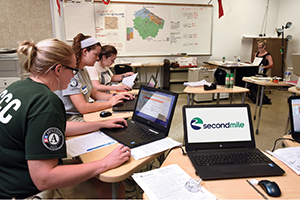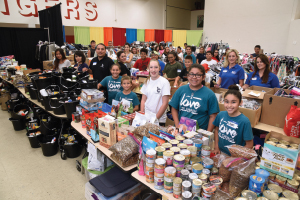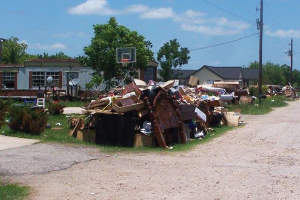Posted on Jul 31, 2016 in
FEATURES

The aftermath of the Brazos River flooding outside of a Rosenberg home. Photo by Second Mile Mission.
COVER STORY | By M.G. Angulo –
The historic cresting of the Brazos River in June brought a fear-imbued awe to residents throughout Fort Bend County. The mere fact it was happening, and nothing could stop it, was almost unbelievable. It was Memorial Day weekend when a heavy anxiety settled on the shoulders of city officials who knew the Brazos River would crest to the highest level ever recorded in Fort Bend County, eradicating the 50.3 foot record set in 1994.
That weekend, days before the historic crest, Fort Bend County Judge Bob Hebert pleaded with the public to be prepared: “This is a serious incident with a strong potential for an unprecedented 100-year flood event. Residents must consider the potential impact to their lives, their property and their mobility before water levels rise and it is too late.”
The knowledge of possible flooding, however, was on officials’ minds as early as April, which is when Hebert signed a disaster declaration for the county in response to the significant rain already seen in the area. “Fort Bend County residents need to understand the severity of this incident,” Hebert said about the declaration signed on April 18th. “This is not a normal rain storm like we’re all used to dealing with. This situation is severe, and an abundance of caution is required of us all.”
True to the conjectures, the Brazos River made its highest crest ever at 54.74 feet on June 2nd affecting 50,000 residents in Fort Bend, as well as 16.81 percent of the county. As the rushing waters began to rise swallowing streets, lawns, barriers and the wheels of vehicles, creating an eerie water world, many residents had no choice but to abandon their homes and properties, and as they sought safer grounds, they watched helplessly as the everyday makings of their lives disappeared beneath the murky water.
Although families faced losses unlike anything they had experienced before, they also were embraced by members of their own community devoted to helping them reclaim a sense of normalcy.
In Recovery Mode

Kerstin Becker, Elizabeth Chalfin and Sarah Tapp volunteered in the data entry room at the Brazos River Flood Recovery center.
On Saturday, June 4th, two days after the historic cresting, community leaders united to create Brazos River Flood Recovery, a county-wide hub of organizations assisting and providing relief with B. F. Terry High School in Rosenberg as its headquarters.
Former Rosenberg Mayor Vincent Morales, who played a vital role bringing organizations together, said the willingness to help was not something anyone gave a second thought about. “We recognized that so many of our friends and neighbors were in serious need,” Morales said. “They needed immediate relief. They needed help now.”
Working alongside Morales was Quart Graves and Cliff Parker, both owners of Chick-fil-A franchises, Pastor Jimn Kyles of the CHURCH, Sarah White with Second Mile Mission, the Central Fort Bend Chamber and Lamar Consolidated ISD, not to mention scores of volunteers. At the initial Brazos River Flood Recovery meeting, Cliff Parker, who has extensive recovery knowledge through his experience with the Hurricane Katrina relief effort, provided a plan for stationing a recovery center at Terry High School, which is where the CHURCH was already meeting every Sunday. “We’re a portable church,” Kyles explained. “So we already had the tools and equipment, and the volunteers, to set something up.”
Kyles then partnered with Second Mile Mission, which quickly set up a station at the high school to assist with needs. “We were asked to duplicate the operations we have in our facility in Missouri City, where we serve people in need from all over the county with basic needs and resources to take next steps in their lives,” said White, the executive director of Second Mile Mission, a local nonprofit. “We set up a registration and intake area, where we listened to families and got a sense of their needs.”
GET THE HELP YOU NEED
The voluntary agencies assisting residents with clean-up on damaged property are using a single tool called Crisis Cleanup to assign work to individual work teams to make sure no one falls through the cracks. These teams will help tear out drywall, rip up carpets, move trash to the curb and sanitize for mold and disease prevention. To get added to the site, call Crisis Cleanup at 1-800-451-1954.
If you need help for housing, bills, rent or more, call 2-1-1 for the United Way of Greater Houston’s help line. The United Way phone operators are trained specialists who have access to a list of resources and know how to find you appropriate help. When you dial 2-1-1, press a number to select the language you speak the most, press 1 for “Services Available in Your Area,” enter your zip code, and the system will connect you with a specialist who will find you help.
Representative Pete Olson’s office will assist constituents needing help with federal recovery assistance. Visit his website to begin the casework process at www.olson.house.gov and click on “How Can I Help.”
Local assistance is provided at the following areas:
 Rosenberg-Richmond Helping Hands, Inc.
Rosenberg-Richmond Helping Hands, Inc.
902 Collins Road
Richmond, TX 77469
281- 232-4904
Catholic Charities
Mamie George Community Center
1111 Collins Road
Richmond, TX 77469
281- 202-6200
Katy Christian Ministries
5510 1st Street, Katy, TX 77493
281-391-5261
Fort Bend County Social Services
4520 Reading Road, Suite A-900
Rosenberg, TX 77471
281-238-3502
Second Mile Mission Center
1135 Highway 90A
Missouri City, TX 77489
281- 261-9199
Brazos River Flood Recovery
Flood Survivor Care Line
281-967-3072
Kyles said despite the fact that wreckage of this magnitude was foreign to most people in the area, the participants in the Brazos River Flood Recovery movement brought expertise and dedication to the table, which is why the recovery effort was so successful.
The same evening, the recovery effort was put into play. Volunteers had helped 47 people before the doors had even officially opened. By Monday, June 6th, the Brazos River Flood Recovery had serviced 1,000 people, and by June 7th, word had hit the streets of where people could go for help. “The first official day at B.F. Terry, we saw more than 200 families,” White said. “This is triple what we normally see at Second Mile in Missouri City.”
Representatives from the Fort Bend County Office of Emergency Management visited the Brazos River Flood Recovery center and designated the site as a Multi-Agency Resource Center. After that, organization after organization joined the recovery effort.
“It has been amazing to see everyone come together,” Kyles said. “In all, 137 organizations came together to meet the needs of those in our cities.”
Exceptional Volunteers

Volunteering at the Brazos River Flood Recovery center were Deanna Mellas, Kristy Santeoia, Kami Sosa, Ariana Flores, Quyen Nguyen, Briana Kyles, Madelina Martinez, Zelda Sosa, Brian Sosa, Caden Kyles, Carson Kyles, Steven Gomez, Kaylin Sosa, Max Vides, Brianna Thomas, Brian Thomas, Will Pineda, Marjorie Villafranco, Jaela Mohr, Jessica Mohr, Alexis Alamia, Leilani Tellez, Marleny Pineda, Maxie Garcia, Ashley Navarro, Annie Rule, Krystal Negrete, Aaron Walsh, Vincent Flores, Brandon Kyles, Jacqueline Tran, Hannah Kirby and Matthew Puentes. Photo by Nesossi Studios.
Like the wheels in a large machine, the volunteers of the relief effort — more than 2,800 people who have contributed more than 21,000 hours as of late June — kept things moving forward. “The volunteers are a perfect example of people who came together for a cause that is much greater than themselves,” Kyles said.
“They’ve done so much more than they even realized to make this possible,” White said of the volunteers, most of whom came from the CHURCH’s volunteer base. “They’ve done a world class job of feeding, receiving and receipting every donation, sharing stories on social media and bringing awareness of the conditions at ‘ground zero’ of the flooded areas.”
Volunteers from throughout the community showed up to do what they could to help those in need, as well as show their support for the organizations coordinating the relief effort. United States Representative Pete Olson and his wife Nancy toured and volunteered at the center where he said, he, too, was gratified by the efforts of ordinary people doing exceptional work. “As our region continues flood recovery efforts, I put hundreds of miles on my truck touring the areas of Texas 22 most impacted,” Olson said. “It was heartwarming to see folks stepping up to help one another in a time of need. Texans helping Texans is what makes our state the best place on earth to live and raise a family.”
Local officials shared Olson’s praise of an exceptional example of a community coming together. “This group did such an amazing job of coming in and pulling together all of the different organizations and resources needed to help people recover,” said Richmond Mayor Evalyn W. Moore. “They came in immediately and stepped up to help people all over the county, and when those affected couldn’t come to Terry High School, relief came to them. The recovery team went throughout the county to provide much needed supplies including AccessHealth’s mobile unit providing vital health care. I couldn’t be more proud and thankful for the many organizations involved in this relief effort.”
In It for the Long Haul
Relief work is no stranger to White, who participated in relief work during Hurricanes Katrina and Rita, but she said she has noticed a key difference with Brazos River flood tragedy. “With Hurricane Katrina, people were looking for a place to land. With this flood, you have families deeply rooted. People wanted to be in their city because they love it, and they have family here. Many families stayed together, even if on the second floor of their flooded home. We met a guy who had been sleeping in the woods. Local hotel rooms were full. I’ve never seen anything like it.”
FEMA Flood Recovery (Do's and Don'ts)

On Saturday, June 4th, Second Mile Mission went mobile to Rosenberg to serve flood affected families and help clean up neighborhood debris in partnership with a group of nonprofits, churches, businesses and organizations. Photo by Second Mile Mission.
Do:
- Do file a claim with your insurance company.
- Do register for FEMA disaster assistance. Survivors can register online at disasterassistance.gov or by calling toll-free 800-621-3362 or TTY 800-462-7585. Those who use 711 or VRS may call 800-621-3362.
- Do know that FEMA grants may help pay for a temporary place to stay, make essential repairs or replace certain damaged contents.
- Do inspect for structural damage before entering their home.
- Do report flood damage to local officials.
- Do throw away wet contents such as bedding, carpeting and furniture. These items may be a health hazard due to mold.
- Do take photographs of flood damage. The insurance company may want to see these.
- Do keep recovery-related receipts. FEMA or the insurance company may want to see these.
- Do return a completed application for a low-interest disaster loan if a FEMA registrant has been referred to the U.S. Small Business Administration. Returning the application is necessary for FEMA to consider them for grants.
- Do remember that FEMA grants do not need to be repaid, are not taxed and do not affect other government benefits.
Don’t:
- Don’t submit more than one registration per household.
- Don’t wait for visits from FEMA or insurance adjusters before cleaning up flood damage and starting repairs.
- Don’t wait for an insurance settlement to register.
- Don’t worry that federal disaster assistance is taking money away from someone else. FEMA provides assistance to all eligible applicants.
- Don’t assume only homeowners can apply for help. Renters may qualify for assistance too.
“The work is far, far from over,” Kyles said, adding the Brazos River Flood Recovery has no plans of disappearing. “The work is just beginning. This is going to be a long process and it’s going to take years.”
In June alone, more than 4,500 people were served at the Terry High School site. While the recovery center has been a success, it will have to relocate before school starts, but that is just one of the concerns of Brazos River Flood Recovery. “Temporary and long-term housing is at the forefront of everyone’s thoughts,” White said. “It’s a top priority for the families affected and for local officials and planners. Along with that, there are immediate needs and interim gap-filling measures to support families until the long-term plan is in place.”
Kyles said the recovery effort is a three-step process. The first step was meeting the emergency needs, which Brazos River Flood Recovery effort did starting June 4th, but the relief effort is in the second step, which is focused on temporary housing. “We’ve begun working with the Office of Emergency Management and city officials to make sure there is temporary housing available to people while their homes are being repaired,” Kyles said. “Federal Emergency Management Agency (FEMA) also recognizes this need and is setting up options.
“In addition to temporary housing, our ongoing goal is to connect people to the right agencies,” Kyles added. “United Way, FEMA, AccessHealth and the like. And this is why we liked to have families come to us, because they could get information on three or four services at a time in one location.”
But what Kyles stresses is that there is a long-term plan in play. “Those affected by the flood will not be forgotten,” Kyles said. “There is hope, and we’re here for the long haul so we can help them rebuild their lives.”
The long-term plan focuses on actually restoring the homes of those affected by the flood. Kyles said Brazos River Flood Recovery has already secured a warehouse where supplies and equipment will be stored, managed and protected so that when families are ready to start rebuilding, those supplies will make it to those in need.
“We need your help. Don’t think this is over. It’s just begun,” said White. “Around 90 percent of what we received is clothing, but that’s not all we need going forward.” For the long-term, gift cards to Lowe’s and Home Depot are being requested to assist with home repair.
“We will need financial help for supplies and manpower for the long-term plan to work,” Kyles said. “We will need people to come out and help clean, and those who will donate time and supplies. We need people to stay plugged in.
“There is something we say at the CHURCH: ‘I was made for this,’” Kyles added. “We were made to make a difference in our cities and communities. We were made to help. I look around, and you know, I’ve never seen anything like it — people coming together to do whatever it takes with no other agenda aside from helping people. What an amazing thing to witness.”
Call the donation hotline at 832-449-2485 to help with the Brazos River Flood Recovery effort.


 <
<








 Rosenberg-Richmond Helping Hands, Inc.
Rosenberg-Richmond Helping Hands, Inc.
